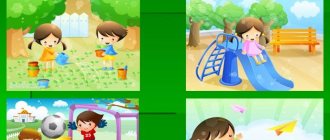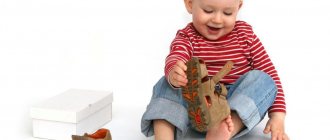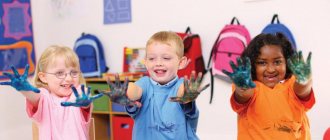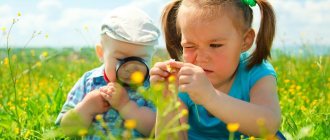Consultation for parents on the topic: “Spring”
Consultation for parents. Topic: “Spring is walking across the planet”
Winter is over. Severe frosts and snowstorms are behind us. The sun is getting warmer and stronger every day, the streets are becoming brighter and walking with the kids is a pleasure. Spring is the most useful and pleasant time of the year for walking with children. It is in the spring that the sun produces a lot of ultraviolet radiation, which is extremely necessary for a child's growing body. Walking in the fresh air is always an interesting and useful activity.
Spring walks are extremely beneficial from the point of view of the baby's early development. Walk with your child along the street, in the park, see what changes are taking place in nature: how the buds swell, the first leaves and grass emerge, what spring flowers exist. Watch birds build nests in the trees. You can even try building a birdhouse and hanging it next to your house. Observing nature is a very interesting and educational activity. It forms in children knowledge about nature, teaches them to observe and contemplate, and develops an aesthetic principle.
In the process of observation, children learn to distinguish shapes, sizes, colors, the nature of the surface and much more. When observing living beings (insects, birds, animals), children learn the nature of movement, sounds and various characteristics. During these observations, children develop qualities such as intelligence, observation, analytical abilities, the ability to compare and draw conclusions.
In spring, observing nature is much more interesting than in winter. While walking with your baby, tell him about spring: why the snow melts, where numerous streams come from, why the sun shines so brightly and why the sky is blue and not gray. Try to hear “spring” sounds with your child: the ringing of drops, the murmuring of streams, the singing of birds.
Tell your child what smells spring brings: melted snow, birch buds, first snowdrops and others. Tell your child what happens in the spring, after the snow melts, migratory birds return from southern countries, buds swell on the trees, the first grass emerges from under the snow, snowdrops bloom.
Show your child the willow, let him touch it, tell him that the willow is one of the first to bloom in the spring; bugs, flies, and butterflies flock to its smell. Let the baby pick a few branches and take them home, invite him to put the bouquet in a vase with water and watch how the branches change, how the first leaves appear on them.
Explain to your child why all these changes occur, introduce him to the concept of “season”. Talk about why it was necessary to dress warmly in winter, but in spring you can walk in lighter clothes.
Choose an object on the street for comparison and watch how it changes every day. For example, pay attention to the child on a spring walk that today there is still snow in the clearing, but tomorrow there will be just wet ground, in a few days you will be able to see the first grass, and then bright flowers.
With such communication, the child’s vocabulary expands and active speech develops.
Also, walking is a useful physical exercise that anyone can do, regardless of age. While walking, a person uses almost all the muscles of the body, the muscles of the arms, back, pelvis and legs work especially well. In addition, such walks are extremely important for the health of various body systems. And this is not all the benefits of such exercises in the fresh air.
Walking perfectly activates vital processes in the body. Be sure to involve your children in such activities. Add children's games to constant walks, as well as entertainment in recreation parks, and you will be surprised at how rarely your child starts to get sick.
Spring walks should not be canceled even if the weather is not sunny.
To begin with, you should simply take it for granted that whether you like it or not, the child will still climb into the deepest puddle and find thicker dirt. The baby wants to know everything, to experience first-hand what his mother warns about. Therefore, be patient and do not scold the baby. It’s so interesting how your reflection looks in a puddle, how the dirt sticks to your boots. How fun it is to splash the water with your hands and make Easter cakes from wet soil!
If you don't want your child to flop around aimlessly in the mud during a spring walk, show him that this can be done with benefit. Does your baby want to dig? Invite him to do this under trees, where the ground is at least slightly covered with leaves and grass. If a child is drawn to water like a magnet, then let him walk through the puddles, show how interesting it is to float boats or just blades of grass, sticks or leaves along streams. You can take radio-controlled toys with you on a walk. Spring is a great time to fly RC helicopters or airplanes.
Try not to forbid your child to experiment, because this can lead to isolation and indecisiveness in the child in the future. Let your little one make the right decision for himself, even if you end up bringing home a grimy baby. Let your child grow up healthy, active and happy!
What to do with a child on a walk in the spring?
1. “Count the birds.” In spring, nature comes alive. And even if the leaves have not yet appeared, the birds have already begun to enjoy the warmth and smells that the spring air is rich in. With a child who can count, you can play the following game: who will notice more birds during a walk. You can finish the game as follows: feed the birds millet or special food .
2. “Steps of a Lilliputian.” This game is good for several children or the whole family to play. Choose a goal and mark a starting line. Let the players compete: who will cover the distance faster with Lilliputian steps (these are steps when a leg is placed close to the other leg during a step).
"Giant Steps" The meaning of the game is the same. However, now the child must spread his legs as wide as he can (adults may give in a little...).
3. “Letting in the sunbeams.” If the weather is sunny, don't forget to take a mirror with you. The baby will be happy to make the day even sunny by letting the sun shine on houses and trees. Choose some distant target and practice who can launch the bunny that far.
4. “Let’s go swimming in the puddle.” Make boats at home or on a walk, and then launch them in the nearest puddle.
5. “Let’s let the bubbles… go swimming!” You can let not only boats sail through puddles, but also soap bubbles. They will last longer on the water and shimmer with all the colors. Watching such swimmers is a real pleasure.
6. “Looking for the first signs of spring.” Arm yourself with a camera and go in search of spring. The first swollen buds, lively birds - all these are the first signs that spring is coming.
7. “Drawing on the asphalt.” If the asphalt is dry, it's time to take out the crayons and draw an invitation to spring: sun, flowers and grass. Perhaps this will speed up the arrival of heat!
8. “Hunt for words and letters.” If the child knows the letters, you can play a game where the child and the adult look around for objects that begin with the selected letter. You can choose different letters. For example, you are looking for words starting with the letter “a”, and the child is looking for words starting with the letter “m”. Who will find the most items?
9. “Developing speed and coordination.” This game is very famous. The rules are simple: children stand between the two leaders, their goal is to knock the players out of the center with the ball. It is best to take an inflatable ball so as not to injure children. Take a larger ball, then the task for the kids will become much more difficult, and the risk of injury will decrease.
10. “Developing coordination.” Participants stand opposite the leader. The game is very simple. All children must show movements opposite to those shown by the leader. For example, if the leader lowers his hands, the kids should raise them, if the leader crouches, the children should jump, etc. If the kid makes a mistake three times, he is eliminated. The winner is the one who can survive the longest.
11. “Developing balance.” For this exercise, you need to place two children opposite each other at a distance of 2-3 child steps. At the signal, one, standing on one leg, with his palms outstretched, should hit the palms of the other baby. The essence of the game is to unbalance your opponent. The one who touches the ground first loses.
12. “Developing speed of movement.” For this game you need a ball and chalk. On the asphalt, draw a circle with a diameter of about 2 meters and indicate the directions of movement. The child stands in the center and hits the ball on the ground, after which he runs away in the given direction. While the ball makes 3 hits, the baby must run. The one who runs farthest wins. This game is group, but can also be played alone.
13. “Developing jumping ability.” This game requires several players; you should divide them into teams. A line is drawn on the ground with which the length of the jump will be measured. The landing site should be marked on the heels. You need to jump in the opposite direction from the marked place; another participant must do this. His main task is to jump over this result and jump further, thereby earning a point for his team. The team with the most points wins.
Outdoor games are always fun and exciting! Play with your child - this strengthens the bond between parents and children, and also helps create more reliable, trusting relationships in the family. We remember from childhood that “the sun, air and water are our best friends.” It’s just a matter of making sure that our kids grow up surrounded by these faithful “comrades” from the very first days.
Planning work with children and parents for March
Plan of joint work with parents for 1-2 weeks of March 2016.
Prepared by teacher Dutova L.K.
MARCH
- Conversation with parents about the appearance of their children.
- Organize an exhibition of works “Portrait of my mother”.
- Celebration dedicated to Women's Day on March 8, with the participation of parents.
- Organize gatherings “My mother is a craftswoman” (introducing the hobbies of mothers and their daughters, family traditions).
- Consultation “The role of the family in the physical education of the child.”
- Consultation on the topic “Health is the head of everything.”
- Conversation with parents on the topic “Caution, ice drift.”
- Consultation “Development of a child’s creative abilities.”
- Safety briefing “What is the danger of a thaw outside.”
- Organize a meeting of the parent committee on the topic “Preparing for the prom.”
- Consultation “Communication of children with peers.”
- Consultation “Entertaining mathematics at home.”
- Consultation “Form healthy habits in children.”
- Memo for parents "Safe steps towards road safety."
- Consultation “Child and the road. Rules of conduct on city streets."
- Consultation “The ABCs of Traffic”.
- At the round table “Ways to develop the memory of a 6-7 year old child.”
- Decorating a parent's corner with a spring theme.
- Work with parents according to needs.
- Participation of parents in creating a developmental environment.
- Decoration of parent corners.
Plan for working together with children for March 2016.
Prepared by teacher Dutova L.K.
S.R.I.
“Family” - expand children’s understanding of collective housekeeping, the family budget, family relationships, and joint leisure activities; cultivate love and benevolence. Caring attitude towards family members, interest in their activities.
Coloring pages "Pancakes"
C: develop imagination, imagination of children.
Encouraging children to engage in independent activities in centers: books, nature, art. creativity.
Drawing
"Maslenitsa
C: Continue to consolidate children’s knowledge about the national holiday “Maslenitsa”; the main attributes of the holiday are the Sun and stuffed animals; fun and joy; be able to place the drawing in the center of the sheet; continue to develop accurate drawing skills
Sweet hour
“My mother is the best” - cultivate a kind, attentive, respectful attitude towards elders, the desire to help them.
“Waltz of the Flowers” - strengthen the skills of setting a festive table, culture of behavior at the table; ability to perceive a calm melody; introduce the history of the tape recorder.
Conversation
“All kinds of mothers are important” - to form a caring attitude towards parents (mother); develop children's speech; learn to write a descriptive story about your mother.
“Spring is red” - to help clarify and generalize ideas about spring; perceive the beauty of nature through the poetic lines of poets; cultivate respect for the storyteller and the ability to listen.
Recommendations for parents “Spring” for the second younger group
Topic: “Caution - Spring has come!” Target
: introduce students to the rules of behavior on ice, on the roads, on the streets of a populated area. Introduce them to safety measures, consolidate the acquired knowledge in a practical way.
Be careful - Spring has come!
The snow is still white in the fields, And in the spring the waters are noisy - They run and wake up the sleepy shore, They run and sparkle and shout.F. I. Tyutchev.
Spring walks are extremely beneficial. In spring, nature comes alive. And even if the leaves have not yet appeared, the birds have already begun to enjoy the warmth and smells that the spring air is rich in, but it is always necessary to remember that Spring is a time when you need to be extremely careful. The spring rays are already hot and are starting to warm up. Danger is everywhere. During the winter period, ice formed on the roofs, icicles hung, and you need to be extremely careful when walking under the roofs of houses.
Safety measures when walking near buildings and structures:
When approaching a building or structure, you need to carefully look at the roof and make sure that snow is possible. do not stand under the eaves of buildings on which icicles have formed; — if possible, free the building’s cornice from any icing that has formed; — if you need to pass under the icy cornice of a building, try to overcome it as quickly as possible to protect yourself.
The second danger in spring is frosty nights. During the day, at positive temperatures, the snow melts, and at night, at negative temperatures, ice forms. The resulting skating rink on sidewalks and roadways poses a serious danger to all road users. Safety measures for icy conditions:
You need to move carefully, slowly, you should step on the entire sole, taking into account the unevenness of the surface; — When there is ice, you should pay attention to your shoes: choose non-slip shoes to feel more confident on an icy road; — Be extremely careful on the roadway, try to avoid all places with an inclined surface. — You need to move on the sidewalk and not cross the roadway unless absolutely necessary. If there is no sidewalk, and you need to continue driving, then you need to move along the edge of the roadway towards moving traffic, so you will notice the approaching car in advance. - You should not cross the roadway near moving cars, you can slip and get hit by the wheels of a car. Remember that the braking distance of a car increases significantly in icy conditions. — If you slip, sit down to reduce the height of your fall.
The biggest danger is ice on water bodies. Without realizing the full danger, teenagers tend to go to water bodies in their free time. Thin ice and formed polynyas are the first enemies of people walking in dangerous places. Since the clothes a person is wearing are warm (winter), once under the ice, they absorb like a sponge and pull the person to the bottom. The water is cold and hypothermia of the human body is possible. The ice near the coast is considered the thinnest, and you need to think about whether it is worth going out on the ice. Under no circumstances should fishermen drill many holes nearby. Adults! Do not leave children unattended !
March 27, 2018 by admin



